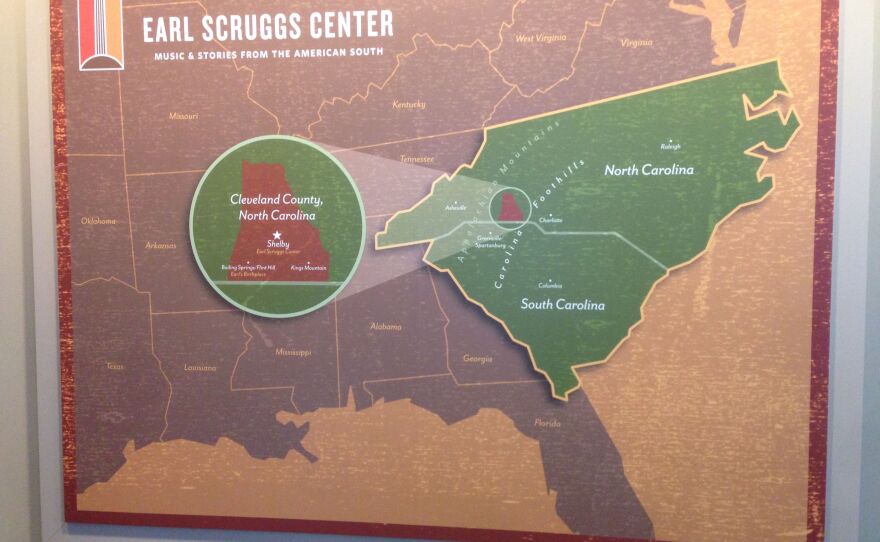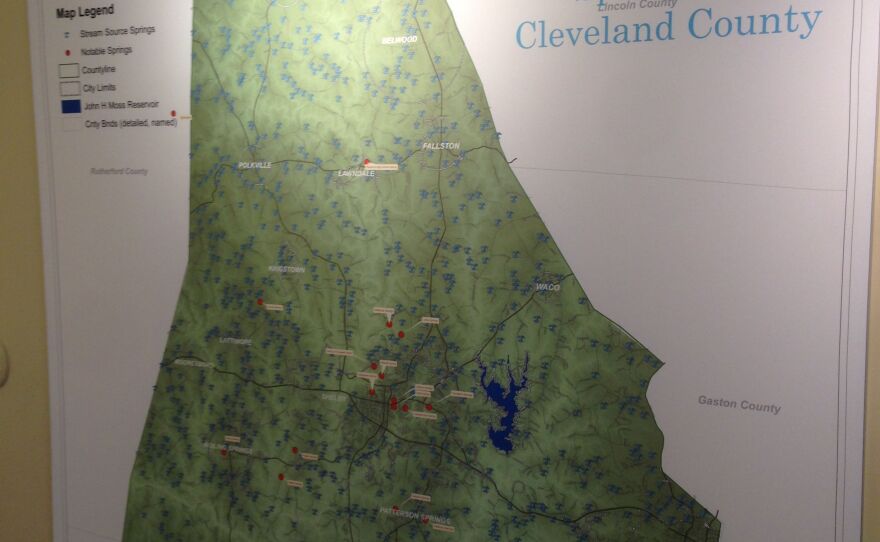Saturday's a big day in Cleveland County. In downtown Shelby, people are gathering for the grand opening of the Earl Scruggs Center. The museum and cultural center in the old county courthouse has been in the works for more than seven years. Its namesake, the late bluegrass legend Earl Scruggs, was born and raised in Cleveland County and kept ties to the area after he left and hit it big in Nashville. WFAE's Duncan McFadyen recently got a peek behind-the-scenes as workers were putting the finishing touches on the exhibits.
The Earl Scruggs' Center's glass front doors were covered over with bright blue holiday wrapping paper for about a month before the grand opening. Executive director Emily Epley says they papered over the glass because so many people were curious about what was happening inside.
“We didn’t want people to see anything until it was ready to reveal," she says, "and we figured we could at least be festive with the little [holiday] print there.”
From the other side of the doors, you can see why they went to the trouble. You’re greeted by a tall glass case that holds Scruggs family musical instruments. Scruggs' nephew J.T. Scruggs points out an old, open backed banjo.
“That’s my grandfather’s instrument," he explains, "and as I understand it, that’s the banjo that Earl first started picking and learning to play.”
The instrument case sits in the middle of the Scruggs Center’s main floor, tying together the four permanent exhibit rooms.
It’s a $5.5 million, 10,000 square foot facility with knobs, buttons and touchscreens that control dozens of sound and video installations.
It would be hard to tell the story of Earl Scruggs without sound. The way he picked the banjo---using his thumb and first two fingers---revolutionized bluegrass music. By using three fingers, Scruggs could syncopate phrases, or change the way rhythms were emphasized, creating what are called “rolls.” You can hear it in Scruggs’ famous “Foggy Mountain Breakdown.” This style of playing is now known as “Scruggs style.”
The Scruggs Center tells the story of the place Earl grew up as much as it tells his own personal story. It includes items from the Cleveland County museum, which shut down a few years ago.
“The way that we look at this is that you can’t tell the story of Earl Scruggs without telling the story of where he came from,” executive director Emily Epley says. “And since it’s Cleveland County, you’ll see a whole lot of Cleveland County all throughout.”
As with most of the North Carolina foothills, the backbone of the Cleveland County economy for much of the 20th century was the textile industry. And Earl’s first job, like many young men in his time, was at a cotton mill. His nephew J.T. says music was a part of the workers’ day.
“He loved to talk about when break would come, he and a lot of the other guys would not go eat, they’d go sit in the back of the cars and play music," he recalls. "Eventually, the supervisor would come out and say ‘OK guys, it’s time to get back to work.’”
You can see some equipment from the mill where Earl worked, and beside it, his first banjo tuner, which was based on cams he saw in the mill’s machinery.
Of course, the museum follows Scruggs’ musical career, starting with his first big break at Nashville’s Ryman Auditorium in 1945. There’s a mock up of what it looks like to stand on the stage there.
An array of old TV sets fitted with new screens plays videos from the iconic Flatt and Scruggs days. There’s an autographed script from an episode of “The Beverly Hillbillies” when Earl and Lester Flatt made one of several cameo appearances, a privilege that came from writing the show’s theme song.
But, the Scruggs Center goes beyond bluegrass. Epley says it’s important to remember that Scruggs didn’t limit himself to one style of music for his whole career.
“Earl was not a bluegrass musician; he was a musician," she explains, "and he played a lot of different kinds of music with a lot of different people.”
Among them, Bob Dylan and sitarist Ravi Shankar. You can see these performances and other artists Scruggs played with and influenced in a nook labeled “The Earl Effect.”
Vince Gill, Travis Tritt, and Sam Bush are among the artists who will pay tribute to Scruggs’ influence on the world of music at a sold-out concert Saturday night in Shelby. While they’re in town, the Scruggs Center will invite them to add their memories of Earl to the archives in its on-site recording booth. The Center’s full name includes the subtitle: “Music and Stories from the American South,” and as part of its mission, all visitors will get a few minutes to share their stories of how music plays a part in their life.
More information about the Earl Scruggs Center.









